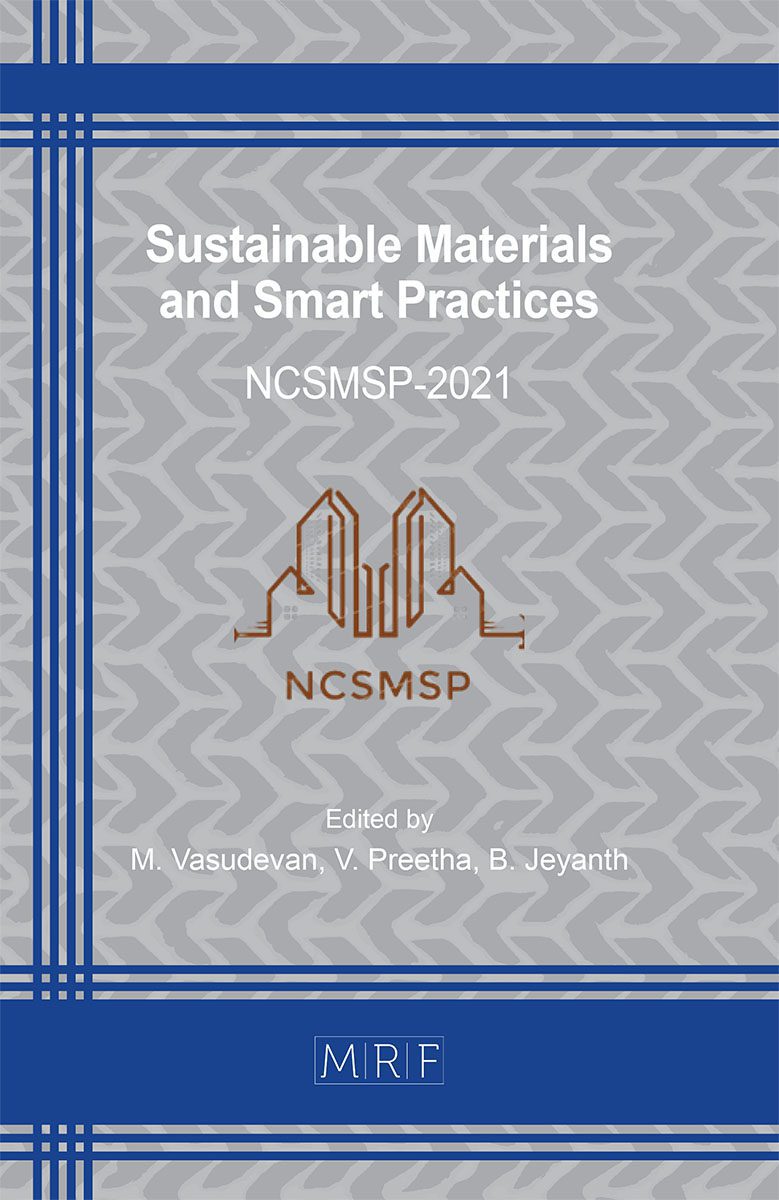Investigating the Possibility of Using Clay and Fly Ash in the Production of Geopolymer Mortar
N.V. Manjunath, B.S. Hariprasath, S.K. Sreehaswanth, T. Gopi
download PDFAbstract. The concept polymer concrete has numerous advantages over the convention concrete similarly in mortar also which uses reactive silica presented in the pozzolanic materials which is activated using alkaline materials. This paper focused on the Geopolymer mortar with fly ash and clay as raw materials and M-Sand for fine aggregate instead of river sand. Different combinations of mixtures were prepared and compared with ordinary cement mortar. The objective of this research is to identify the properties of different combinations of geopolymer mortars with conventional cement mortar, in which the fine aggregate sourced from riverbeds is replaced by Fine aggregate manufactured using Crushing stones and testing it for compressive strength, water absorption, residual alkalinity, and acid resistance. Fly ash- clay based geopolymer shows good acid resistance and shows less reduction in weight and compressive strength than ordinary cement mortar. Permeability of geopolymer mortar is less that of ordinary cement mortar. Alkalinity of geopolymer mortar is 4-20 % higher than that of ordinary cement mortar. Fly ash- clay based geopolymer has excellent compressive strength (75.7% for red clay and 52.6% for fire clay) than the conventional cement concrete and is suitable for structural applications.
Keywords
Geopolymer, Fly Ash, Clay, M-Sand
Published online , 10 pages
Copyright © 2022 by the author(s)
Published under license by Materials Research Forum LLC., Millersville PA, USA
Citation: N.V. Manjunath, B.S. Hariprasath, S.K. Sreehaswanth, T. Gopi, Investigating the Possibility of Using Clay and Fly Ash in the Production of Geopolymer Mortar, Materials Research Proceedings, Vol. 23, pp 444-453, 2022
DOI: https://doi.org/10.21741/9781644901953-48
The article was published as article 48 of the book Sustainable Materials and Smart Practices
![]() Content from this work may be used under the terms of the Creative Commons Attribution 3.0 licence. Any further distribution of this work must maintain attribution to the author(s) and the title of the work, journal citation and DOI.
Content from this work may be used under the terms of the Creative Commons Attribution 3.0 licence. Any further distribution of this work must maintain attribution to the author(s) and the title of the work, journal citation and DOI.
References
[1] Muthadhi A, Vanjinathan J, Durai D (2016) Experimental investigations on geo polymer concrete based on class C fly ash. Indian Journal of Science and Technology 9: . https://doi.org/10.17485/ijst/2016/v9i5/87270
[2] Saravanakumar P (2018) Strength and Durability Studies on Geopolymer Recycled Aggregate Concrete
[3] Pradeep Kumar S, Kameswara Rao B, Guru Jawahar J (2018) Experimental investigation on fly ash and GGBS based geopolymer concrete incorporate black marble waste aggregate. International Journal of Engineering and Technology(UAE) 7:1233–1236 . https://doi.org/10.14419/ijet.v7i3.12486
[4] Simon S, Hemamathi A, Jenishtalouis J (2019) Strength assessment on flyash based geopolymer concrete. International Journal of Innovative Technology and Exploring Engineering 9:3956–3960 . https://doi.org/10.35940/ijitee.A5034.119119
[5] Srinivas T, Manoj Anand P (2019) Permeation properties of geopolymer concrete made with partial replacement of recycled coarse aggregates. International Journal of Innovative Technology and Exploring Engineering 8:2987–2990 . https://doi.org/10.35940/ijitee.K2317.1081219
[6] Sandeep Kumar AD, Singh D, Reddy VS, Reddy KJ (2020) Geo-polymerization mechanism and factors affecting it in Metakaolin-slag-fly ash blended concrete. In: E3S Web of Conferences. EDP Sciences
[7] Shahedan NF, Abdullah MMAB, Mahmed N, Kusbiantoro A, Tammas-Williams S, Li LY, Aziz IH, Vizureanu P, Wysłocki JJ, Błoch K, Nabiałek M (2021) Properties of a new insulation material glass bubble in geo-polymer concrete. Materials 14:1–17 . https://doi.org/10.3390/ma14040809
[8] Lakshmi Deepak A, Vara Lakshmi TVS (2019) Mechanical properties of geopolymer concrete with flyash and metakaolin. International Journal of Engineering and Advanced Technology 9:3863–3868 . https://doi.org/10.35940/ijeat.A1180.109119
[9] Srinivas T, Koushik RN (2019) Sulphate attack resistance of geo-polymer concrete made with partial replacement of coarse aggregate by recycled coarse aggregate. International Journal of Innovative Technology and Exploring Engineering 8:112–117 . https://doi.org/10.35940/ijitee.L2509.1081219
[10] Raj SR, Arulraj PG, Anand N, Balamurali K, Gokul G (2021) Influence of various design parameters on compressive strength of geopolymer concrete: A parametric study by taguchi method. International Journal of Engineering, Transactions B: Applications 34:2351–2359 . https://doi.org/10.5829/IJE.2021.34.10A.16
[11] Pu BC, Liu B, Li L, Pang W, Wan Z (2021) Influence of polypropylene fibre factor on flowability and mechanical properties of self-compacting geopolymer. Materials 14: . https://doi.org/10.3390/ma14175025
[12] Naveen Kumar G, Kailash Kumar S, Prashanth G (2019) Strengths of geo polymer concrete by adding metakaoline. International Journal of Recent Technology and Engineering 8:2682–2687 . https://doi.org/10.35940/ijrte.B2673.078219
[13] Shashikant, Prince Arulraj G (2019) A research article on “Geopolymer concrete.” International Journal of Innovative Technology and Exploring Engineering 8:499–502 . https://doi.org/10.35940/ijitee.I1106.0789S219
[14] Rambabu G, Naidu DA, Venkateswarlu D (2019) Experimental developments on corrosion resistivity of low calcium fly ash-based geopolymer concrete. International Journal of Recent Technology and Engineering 8:5320–5327 . https://doi.org/10.35940/ijrte.B1089.078219































